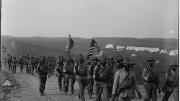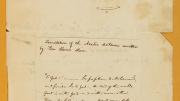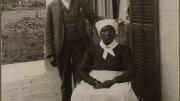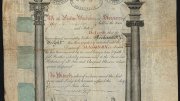“These voices that exist in our collections, they’re always just waiting for us to listen to them.” That’s how Dorothy Berry, the digital collections program manager at Houghton Library, thinks about the African-American writers, thinkers, and ordinary people dispersed throughout the library’s holdings, in books, letters, photos, pamphlets, manuscripts, and countless other artifacts. “It can be hard to hear them sometimes,” she says, “in a library where there are louder, more famous voices”—visitors stop by regularly, for instance, to see Emily Dickinson’s writing desk—“but these other voices are there.… And at the end of the day, what’s oftentimes true is that people care about things insofar as we let them know about them, insofar as we pursue their interest.”
This summer, Berry proposed a project to make those lesser-known voices a little easier to hear. Amid the pandemic, Houghton’s regular digitization projects have been put mostly on hold, and when protests arose after George Floyd’s killing, it sparked a nationwide hunger to understand black history and experiences. Libraries and institutions seemed suddenly keen to support African-American communities. “It felt like a great opportunity to increase black representation in our digital collections,” says Berry, whose professional background is in African-American-focused archival work. She put together project titled, “Slavery, Abolition, Emancipation, and Freedom: Primary Sources from Houghton Library.” Leading a team of colleagues, she will spend the 2020-21 academic year building out the library’s digital collection of records related to African-American history: thousands of items from the late eighteenth century through the early twentieth.
Importantly, much of the work can be done from home: identifying and researching materials in the catalog, enhancing descriptions, adding new subject headings, and learning more about what’s available. “And then there’s work that periodically I can go in and do personally,” Berry says, “pulling materials, preparing them for imaging services.” The process of digitizing the items will be slower than normal, because of COVID-related safety restrictions, but the plan is eventually to publish a website, available both to scholars and the public, with all the images and information.
Thomas Hyry, Fearrington librarian of Houghton Library and director of arts and special collections at Harvard College Library, emphasized the significance of this effort. “The hard fact is that we have not previously made these collections a priority for digitization, and we think we should not wait any longer,” he wrote in an email. “Our university and nation cannot address the persistent scourge of anti-Black racism without developing deeper knowledge and awareness of American history and culture from a Black perspective, and we believe this project will make an important contribution toward enhancing this understanding.” He added that library administrators see the project as “one part of a strong and multi-faceted commitment to becoming an anti-racist library.”
The items that Berry and her team plan to gather are scattered far and wide across Houghton’s archives. “There are a few distinct collections that are key, or it’s very obvious that we would want to put them in a project like this,” Berry says: government documents from the Freedmen’s Bureau; letters written by black abolitionists including Frederick Douglass, Sojourner Truth, Charles Lenox Redmond, and William Still; meeting flyers and pamphlets tracing decades of political debate on race. “Those run the gamut from abolitionist organizing groups to pro-slavery groups to the narratives of people who self-emancipated and narratives of court cases around the Fugitive Slave Act,” Berry says. Another Houghton collection contains the personal papers, letters, and household bills of the formerly enslaved Carter family of Virginia, who moved to Richmond after the Civil War.
But there are also less obvious entries. One that Berry finds particularly compelling is an 1887 book written by a veteran of the United States Colored Troops, Joseph T. Wilson: The Black Phalanx; a History of the Negro Soldiers of the United States in the Wars of 1775-1812, 1861-'65. Born free in Virginia and educated in Massachusetts, he had been a whaler in the South Pacific and a railroad worker in Chile before enlisting in the Union Army in 1862; after the Civil War, he became a writer, speaker, poet, and activist who fought for black suffrage and full citizenship. Packed with now-obscure knowledge, his book was intended as a work of racial uplift, Berry says, “a way to teach people about the contributions of African Americans to American history. Today we often talk about how African-American history is left out of the curriculum at school—well, this is something people were thinking about in the 1800s, too.”
Another important set of materials relates to what was known as the Colored Conventions, a series of more than 200 gatherings among free-born and formerly enslaved (or fugitive) black people, held from the 1830s through the 1880s. Little remembered now—“They’ve been sort of historically erased,” Berry says—Colored Conventions drew many hundreds to cities like New York, Philadelphia, Charleston, and Washington, D.C., to talk about black rights and discrimination, suffrage and social justice. “What’s great about digitizing these materials is that it puts us in conversation with our colleagues at other universities,” Berry explains. One of the largest scholarly efforts to research and document these gatherings is the Colored Conventions Project, based at the University of Pennsylvania, “and within Houghton’s materials, we could potentially have some items that they haven’t seen and don’t have,” she notes. “That opens a conversation.”
The digital collection Berry is assembling also includes darker elements. “We have at least 26 bills of sale for human beings in our collection,” she says. Mostly, they give first names only, and sometimes not even that. “With a lot of these materials that are violent and painful, I feel that it’s important to make them accessible so that scholars can do their research, but also accessible to people who might potentially be descendants of the enslaved people represented in these documents. And I also think it’s important that if we have material like this, it’s not allowed to live in our shadows.”
The public-facing aspect of the project is crucial, Berry says—the idea that anyone with an internet connection should be able to access the website offering these digitized materials. She’s hoping people can use them for genealogical and family-history research; she’s also hoping people might be able to fill in some missing details—a connection to a name in a slavery register, or an identity for a face in a photo. “Let’s put it all online and see what happens,” she says. “If you're willing to do that, which is different from what places like Harvard usually do, then the chance of somebody out there saying, ‘Actually I know a ton about that,’ feels really high.” After all, she says, in the long history of African-American archival research, “this has never been work that stays in the academy. Because for the longest time, the academy did not value this type of research.”
But ordinary people did.
Berry did, too. For her, it was a kind of birthright. She grew up in the Missouri Ozarks, living in a house that her great-great-great-grandparents had built in 1870, after Emancipation, on land they’d acquired from their onetime enslavers—who were also, Berry says, their blood relatives. “And in the backyard, the far back, there is a cemetery for formerly enslaved people and others who weren’t allowed to be buried in the town cemetery,” she adds. “This is one of those parts of the country, like Appalachia, where the history of slavery and African-American residency is pretty much erased.” A series of lynchings in the early 1900s prompted a mass exodus of black residents, fleeing to the north. Roughly 40,000 people left, she says. But Berry’s family stayed.
They also collected things—heirloom quilts, the original deed for the house, photos dating back to the nineteenth century. “I have my great-great-great-grandmother’s wedding photo from about 1860,” she says. She remembers that when she was a child, a professor from one of the state colleges who was researching African Americans in the Ozarks came through, collecting people’s personal items—“photos and papers and whatever they had. The idea was that it would go to the university and be processed in an archive and then made available to everybody.” Many of Berry’s neighbors donated items, although her family didn’t. But then the funding fell through and the professor died suddenly and her notes were discovered to be largely indecipherable. “These things can be unpredictable,” Berry says. But still: “A lot of that material, it’s in the archive, but it’s basically lost. It’s lost to the people it’s relevant to; it’s lost to its stories.”
That experience shook Berry, and shaped what would become her work. After college, she earned a master’s degree in library science, and another in historical ethnomusicology (specializing in African-American musical theater from the 1890s to 1910s). Before coming to Houghton in 2018, she worked at the University of Minnesota, where she digitized and edited the descriptions of African-American history materials; before that, she was a Mellon Fellow at the National Museum of African American History and Culture and a graduate assistant at Indiana University’s Black Film Center/Archive and the Archives of African American Music and Culture.
The Houghton project, as ambitious as it is, will not be comprehensive, she emphasizes. “This is not everything Houghton has. There’s just too much—we couldn’t get it all.” But the gaps and silences in the materials she and her team are gathering also partly reflect “the fact that sometimes we don't have the full story, because we, meaning society, have actively decided that we think some parts of the story are more interesting than others.” She hopes, though, that the items they are assembling—some 3,200 to start with, chosen with a “curatorial eye”—will open other doors and lead people to unforeseen avenues of research.











